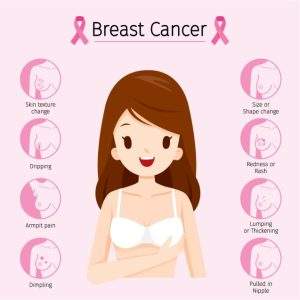Breast cancer is a type of cancer that develops in the breast tissue. It occurs when the cells in the breast start to grow uncontrollably and can invade surrounding tissue or spread to other parts of the body. It is the most common cancer among women worldwide.
Symptoms of breast cancer may include a lump or thickening in the breast, changes in the shape or size of the breast, nipple discharge, or changes in the skin around the breast or nipple. However, some people with breast cancer may not experience any symptoms at all.
There are different types of breast cancer, including ductal carcinoma, lobular carcinoma, and inflammatory breast cancer. Breast cancer can also be classified by the stage, which refers to the extent of the cancer in the body. Staging is determined by factors such as the size of the tumor, whether the cancer has spread to nearby lymph nodes, and whether it has metastasized (spread) to other parts of the body.
Treatment for breast cancer typically involves surgery, radiation therapy, chemotherapy, hormone therapy, or a combination of these approaches. The choice of treatment will depend on the stage and type of cancer, as well as other factors such as the person’s age, overall health, and personal preferences.
Regular breast cancer screening can help detect the disease early, when it is most treatable. Mammograms, breast MRI, and clinical breast exams are all screening options that may be recommended based on a person’s age, family history, and other factors.
Symptoms of Breast Cancer
The symptoms of breast cancer can vary depending on the individual and the stage of the cancer. Some people may not experience any symptoms at all, which is why regular breast cancer screening is important for early detection. However, here are some common symptoms that people with breast cancer may experience:
- A lump or thickening in the breast or armpit: This may be the most common symptom of breast cancer. The lump may be hard or soft and may be painful or painless.
- Changes in breast size or shape: One breast may become larger or smaller than the other, or the breast may become misshapen or asymmetrical.
- Changes in the skin: The skin around the breast may become dimpled, puckered, or red, or there may be changes in the texture of the skin, such as thickening or scaling.
- Nipple changes: The nipple may become inverted (pulled inward), or there may be a discharge from the nipple that is clear, bloody, or milky.
- Pain or tenderness: Breast cancer can cause pain or tenderness in the breast or armpit, although not all breast cancers cause pain.
- Swelling: Some people with breast cancer may notice swelling in the breast or armpit.
It is important to note that these symptoms can also be caused by other conditions, such as benign breast cysts or fibroadenomas. If you notice any changes in your breasts or have concerns about breast cancer, you should speak with your doctor. Early detection and treatment can improve the chances of a positive outcome
Stages of Breast Cancer
All stages of breast cancer can be difficult, and the treatment plan and outcomes will depend on the individual case. However, in general, the later stages of breast cancer (stage III and IV) can be more challenging to treat than the earlier stages (stage I and II). This is because the cancer has spread beyond the breast tissue and may have affected other parts of the body, such as the lymph nodes, bones, lungs, or liver.
In stage III breast cancer, the cancer has spread to nearby lymph nodes or tissues, and in stage IV breast cancer, the cancer has metastasized (spread) to other organs or tissues. Treatment for these stages of breast cancer may involve more aggressive therapies, such as chemotherapy, radiation therapy, targeted therapy, and surgery, as well as palliative care to help manage symptoms and improve quality of life.
However, it is important to note that every case of breast cancer is unique, and the stage of the cancer is just one factor that will influence the treatment plan and prognosis. Other factors that may affect the outcome include the age and overall health of the person, the type and size of the tumor, the hormone receptor status of the cancer, and the presence of genetic mutations
Treatment Options for Breast Cancer
The treatment options for breast cancer depend on various factors, such as the stage of cancer, the type of breast cancer, and the person’s overall health. The goal of treatment is to remove the cancer and prevent it from returning or spreading to other parts of the body. Here are some of the most common treatments for breast cancer:
- Surgery: This is the most common treatment for breast cancer. The type of surgery depends on the size and location of the tumor, and may include a lumpectomy (removal of the tumor and a small margin of surrounding tissue) or a mastectomy (removal of the entire breast).
- Radiation therapy: This treatment uses high-energy X-rays to destroy cancer cells. It may be used after surgery to kill any remaining cancer cells or as the primary treatment for certain types of breast cancer.
- Chemotherapy: This treatment uses drugs to kill cancer cells throughout the body. It may be used before or after surgery, or as the primary treatment for certain types of breast cancer.
- Hormone therapy: This treatment uses drugs to block the hormones that fuel certain types of breast cancer. It may be used after surgery or as the primary treatment for hormone receptor-positive breast cancer.
- Targeted therapy: This treatment targets specific proteins or genes that are involved in the growth and spread of cancer cells. It may be used in combination with other treatments for certain types of breast cancer.
It is important to note that the treatment plan for each person with breast cancer is individualized based on the specific details of their case, and may include a combination of these treatments. Additionally, treatment for breast cancer may involve a team of specialists, including surgeons, radiation oncologists, medical oncologists, and other healthcare professionals
Breast cancer is a complex disease that can have significant impacts on a person’s health and well-being. By understanding the symptoms, stages, and treatment options for breast cancer, individuals can be empowered to make informed decisions about their healthcare and improve their chances of a positive outcome. Regular breast cancer screening and early detection are key in the fight against breast cancer








